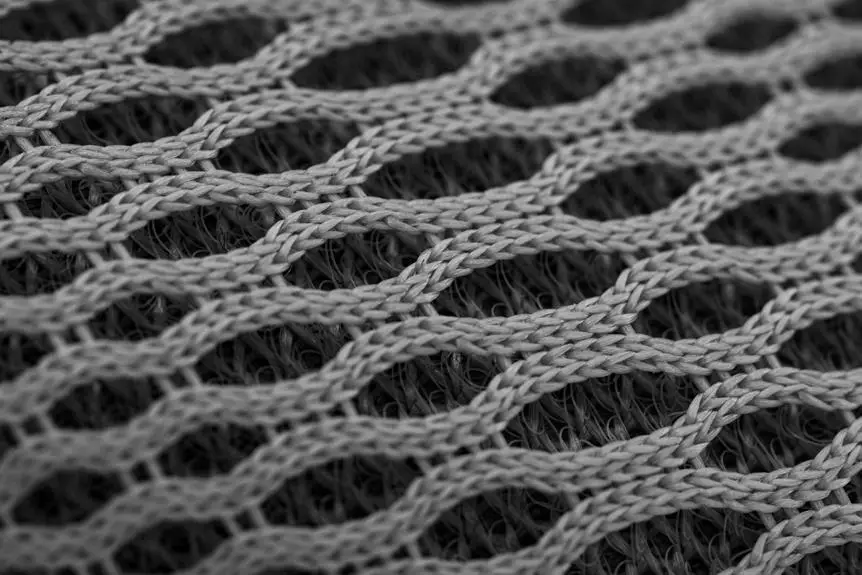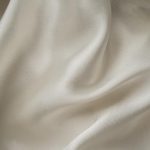If you've ever worn acrylic fabric, you know how annoying static cling can be. It happens due to various factors, like humidity and friction, but there are effective ways to tackle this issue. You're probably wondering what simple adjustments you can make during laundry or when dressing. By exploring the right detergents, fabric softeners, and drying methods, you can significantly reduce that cling. Plus, there are everyday tips that can enhance your experience with acrylic. Curious about the best strategies to keep static at bay? Let's discuss some practical solutions.
Table of Contents
Key Takeaways
- Maintain indoor humidity with a humidifier to reduce static cling in acrylic fabrics caused by dry air conditions.
- Use fabric softeners designed for synthetic fabrics during laundry to minimize static and enhance comfort.
- Choose low or medium heat settings when tumble drying acrylic garments to prevent over-drying and static buildup.
- Apply anti-static spray or rub a dryer sheet on acrylic clothing before wearing to reduce static cling effectively.
Understanding Acrylic Fabric
Acrylic fabric, known for its lightweight and durable nature, is a popular choice in textiles due to its versatility and vibrant color retention. You'll find it used in a variety of applications, from clothing to home decor. Its soft texture mimics wool but offers easier care, making it an appealing option for many.
When you choose acrylic, you're opting for a fabric that dries quickly and resists wrinkles, which means less time spent on maintenance. It's also resistant to moths and mildew, making it suitable for both indoor and outdoor use. If you're looking for warmth without the bulk, acrylic is an excellent choice, as it provides insulation without weighing you down.
One important aspect to keep in mind is that acrylic can be prone to static electricity. This can affect how the fabric behaves, especially in dry conditions. To fully appreciate the benefits of acrylic fabric, it helps to understand its properties and how they work in your favor. Make sure to explore different blends and finishes to find the perfect acrylic fabric that meets your needs.
Causes of Static Cling
Static cling can be a real nuisance, and it often arises from a few key factors.
You might notice that dry air conditions, friction from movement, and the material composition of your fabrics all play a role in this annoying phenomenon.
Let's explore how each of these causes contributes to static cling in acrylic fabrics.
Dry Air Conditions
During winter months or in arid climates, dry air conditions can significantly increase static cling in fabrics. When humidity levels drop, the natural moisture in the air decreases, leading to more static electricity buildup. This means you might find your acrylic clothes clinging to your skin or each other more than usual.
Here are some key factors that contribute to dry air conditions and static cling:
- Heating Systems: Central heating can reduce indoor humidity, making the air drier and increasing static electricity.
- Lack of Moisture: In arid climates, the environment is already low in moisture, exacerbating static cling.
- Cold Weather: Cold air holds less moisture, leading to dryer conditions indoors.
- Insulation: Poorly insulated homes can let in dry air from outside, contributing to static buildup.
To combat this, consider adding a humidifier to your living space or regularly misting your clothes with water before wearing them. Addressing dry air can help reduce that pesky static cling and make your acrylic fabrics much more comfortable to wear.
Friction From Movement
Friction from movement can easily generate static electricity in your clothes, causing them to cling uncomfortably. When you walk, sit, or even shift in your seat, your acrylic fabric rubs against itself or other surfaces, creating that unwanted static charge. The more you move, the more friction builds up, exacerbating the cling.
You may notice this issue more prominently with certain activities, like getting in and out of your car or moving around in a chair. The smooth texture of acrylic can increase the likelihood of static, especially when you're wearing layers.
To minimize this effect, consider wearing an undershirt made from a different fabric, like cotton, which can help absorb some of the friction. Another tip is to keep your movements smooth and deliberate. Rushed movements tend to create more friction, leading to increased static. If you're walking briskly or moving quickly, try to slow down a bit.
Additionally, using fabric softeners during laundry can reduce static by coating the fibers, making them less likely to cling as you move. By being mindful of your movements and fabric choices, you can combat static cling effectively.
Material Composition Factors
Understanding the material composition of your acrylic fabric is crucial, as certain fibers are more prone to generating static cling than others.
Here's what you need to know about common fabrics and their static tendencies:
- Acrylic: While lightweight and warm, acrylic fibers often generate static due to their synthetic nature.
- Nylon: Another synthetic fiber, nylon can produce static cling, especially when dry.
- Polyester: This fabric can also contribute to static, particularly when mixed with acrylic or other synthetics.
- Natural Fibers: Cotton, silk, and wool typically resist static cling better than synthetics, making them preferable choices.
Choosing the Right Laundry Detergent
How can you ensure your acrylic fabrics stay vibrant and soft? Start by choosing the right laundry detergent. Look for a mild detergent specifically formulated for synthetic fabrics. These detergents are designed to cleanse without damaging the fibers, helping to maintain the color and texture of your acrylic items.
Avoid harsh detergents that contain bleach or strong enzymes, as they can cause wear and tear over time. Instead, opt for a detergent that's free from additives that could lead to buildup, which can contribute to static cling.
If you're dealing with specific stains, pre-treat them with a gentle stain remover, but always check the label to ensure it's safe for acrylic.
When washing, use cold water to prevent shrinking and fading. This temperature also helps reduce static buildup during the wash cycle.
Lastly, consider using the recommended amount of detergent; too much can leave residue on your fabrics, which worsens cling.
Fabric Softener and Static Reduction
Using fabric softener can significantly reduce static cling in your acrylic fabrics, making them more enjoyable to wear and handle. By incorporating fabric softener into your laundry routine, you can create a smoother surface on your fabrics, which helps to prevent static buildup.
Here are some tips to maximize its effectiveness:
- Choose the Right Fabric Softener: Look for a softener specifically designed for synthetic fabrics, as these are formulated to tackle static cling effectively.
- Use the Recommended Amount: Don't overdo it; using too much fabric softener can lead to a greasy residue on your clothes, which can actually attract dirt.
- Add During the Rinse Cycle: Ensure you add the fabric softener during the rinse cycle of your washing machine to give it enough time to work its magic.
- Consider Liquid Over Sheets: Liquid fabric softeners tend to penetrate the fabric better than dryer sheets, offering more consistent static reduction.
Drying Methods to Consider
When it comes to drying acrylic fabric, you've got a few effective methods to consider.
Air drying can help preserve the fabric's texture, while using the right tumble dry settings can save you time.
Don't forget that adding fabric softener can also reduce static, making your garments more comfortable to wear.
Air Drying Benefits
Air drying acrylic fabric preserves its vibrant colors and reduces the risk of static cling, making it a smart choice for maintaining your garments. When you opt for air drying, you enjoy several benefits that keep your clothes looking and feeling their best:
- Color Retention: Air drying prevents fading caused by high heat from dryers, ensuring your garments stay bright and vibrant.
- Less Wear and Tear: By avoiding the mechanical action of a dryer, you minimize the risk of pilling and damage, extending the life of your fabric.
- Reduced Static Cling: Air drying helps to decrease static buildup, so you won't have to deal with clingy fabric when you wear your favorite pieces.
- Eco-Friendly: Choosing to air dry reduces energy consumption, making it a more sustainable option for your laundry routine.
Incorporating air drying into your fabric care routine not only helps maintain your acrylic garments but also promotes a more environmentally conscious lifestyle. So next time you wash your acrylic items, consider laying them flat or hanging them up to dry!
Tumble Dry Settings
If you choose to tumble dry your acrylic fabric, selecting the right settings can help maintain its quality while ensuring it dries efficiently. Acrylic is sensitive to heat, so it's crucial to use low or medium heat settings. High temperatures can cause the fibers to become damaged or shrink. Here are some tips to consider:
| Setting | Recommendation |
|---|---|
| Heat Level | Low or Medium Heat |
| Drying Time | Start with 30-40 minutes |
| Dryer Balls | Use to reduce static and clumping |
| Cycle Type | Delicate or Permanent Press |
| Check Periodically | Every 10 minutes to avoid over-drying |
Fabric Softener Use
Using fabric softener can significantly reduce static cling in acrylic fabrics, making them feel softer and more comfortable after drying. To get the most out of your fabric softener and minimize static, follow these tips:
- Choose the Right Product: Opt for a liquid fabric softener specifically designed for synthetic materials. These formulations help reduce static without damaging the fibers.
- Dilute Before Use: Always dilute liquid softener with water before adding it to your wash. This ensures even distribution and prevents residue buildup on your fabrics.
- Add at the Right Time: Add fabric softener during the rinse cycle of your wash. This allows it to properly coat the fibers and effectively reduce static cling.
- Use in the Dryer: If you prefer dryer sheets, toss one in with your acrylic fabrics while drying. This can further help eliminate static and leave your clothes smelling fresh.
Anti-Static Products and Techniques
You can effectively reduce static in acrylic fabrics by employing various anti-static products and techniques.
One of the simplest options is to use an anti-static spray. Just lightly mist your fabric before wearing it, and you'll notice a significant reduction in cling. Look for products specifically designed for fabrics, as these contain ingredients that help neutralize static electricity.
Another effective technique involves using dryer sheets. You can rub a dryer sheet directly on your acrylic clothing to help minimize static cling. Alternatively, toss a dryer sheet into the dryer with your acrylic garments to infuse them with anti-static properties during the drying process.
If you prefer a DIY approach, consider mixing a small amount of fabric softener with water in a spray bottle. Lightly spray the mixture on your fabric before wearing it to keep static at bay.
Everyday Tips to Prevent Cling
Incorporating simple habits into your routine can greatly reduce static cling in acrylic fabrics. Here are some tips to help you keep that annoying cling at bay:
- Moisturize Your Skin: Apply lotion before dressing. Dry skin can contribute to static, so keeping your skin hydrated helps reduce the charge.
- Use Dryer Sheets: Toss a dryer sheet into the dryer with your acrylic items. This can help neutralize static during the drying process.
- Air Dry When Possible: If you can, air drying your acrylic garments can minimize static. Hang them up or lay them flat to dry instead of using the dryer.
- Choose Natural Fibers: When layering, opt for natural fibers like cotton or linen. These materials are less likely to create static electricity compared to synthetic fabrics.
Frequently Asked Questions
Can Acrylic Fabric Cause Allergic Reactions in Some Individuals?
Yes, acrylic fabric can cause allergic reactions in some individuals. If you experience skin irritation or respiratory issues after wearing it, consider switching to natural fibers like cotton or wool to avoid discomfort.
Is Acrylic Fabric Recyclable or Eco-Friendly?
Acrylic fabric isn't easily recyclable, as it often ends up in landfills. While some companies are exploring eco-friendly alternatives, you should check labels and support brands committed to sustainable practices to minimize environmental impact.
How Does Humidity Affect Static Cling in Acrylic Fabric?
Humidity plays a crucial role in static cling. When the air's damp, moisture helps reduce static electricity buildup in fabrics, making it less likely for your acrylic clothes to cling to your skin or each other.
Can I Use an Iron on Acrylic Fabric?
Yes, you can use an iron on acrylic fabric, but be careful. Set the iron to a low temperature and use a pressing cloth to avoid damaging the fabric. Always test a small area first.
What Are Alternative Fabrics to Acrylic for Less Static?
If you're looking for alternatives to acrylic that generate less static, consider natural fibers like cotton, linen, or bamboo. These fabrics tend to be more breathable and less prone to cling, making them a great choice.
- How Does Ring Spun Cotton Affect Garment Fit and Shape Retention? - August 13, 2024
- What Are the Challenges in Producing Ring Spun Cotton? - August 13, 2024
- Is Ring Spun Cotton Suitable for Plus-Size Clothing? - August 13, 2024







